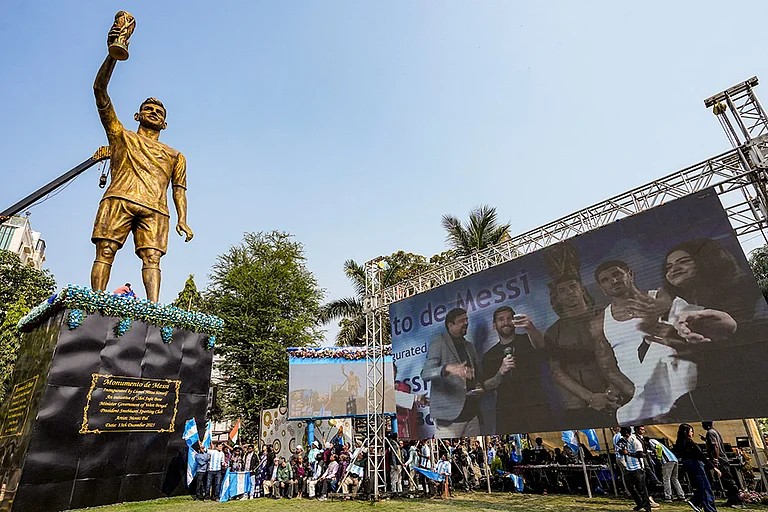The longer I watch the political antics of so-called leaders in the Central and state governments, the more Im filled with despair for the future of India. For the past month, finance minister Yashwant Sinha has been telling his audiences that the next budget will contain some hard decisions. Judging from newspaper reports, in two short cabinet sessions his alliance partners have turned his warnings into just so much empty bluster. Last week, the BJPs partners forced the government to go back on a decision to abolish all vacant posts in the Central government and freeze new recruitment to the Central services, except in a few technical categories. Last Wednesday, they forced it to "postpone" a decision on raising kerosene, LPG and other petroleum prices by two weeks.
In two brute strokes, therefore, BJPs allies have destroyed the pillars of the governments strategy for containing the fiscal deficit of the country. This isnt an exaggeration. Abolishing vacant posts and freezing non-technical recruitment to the bureaucracy is not some knee-jerk reaction to the fiscal crisis the Vajpayee government has suddenly dreamt up.
It was an essential part of the recommendations of the Fifth Pay Commission which the United Front government ignored even while it merrily added 40 per cent to the pay awards of the commission. The commission had recommended this step as it knew that a simple increase in salaries without a cut in the bureaucracy (through superannuation) would plunge the country into a fiscal crisis. When the United Front government did just that, the economist member of the commission, Suresh Tendulkar, moaned in a newspaper interview that the country had committed economic suicide.
The BJPs allies have sabotaged this essential measure for the second time. The real sufferer will not be the Central government but the governments in the states. While the Central bureaucracy has grown by only 570,000 in the past 30 years, the state and local bureaucracies have grown by 8.8 million! Today, all state governments face the task of matching the Centres pay awards, in proportionate if not absolute terms. Its hardly surprising that half of them do not have the money even to pay the salaries of their employees. It was to set an example for the states to follow that the Vajpayee government proposed freezing new recruitment. But the BJPs nda allies have shot it down in exactly the same way as the Janata Dals allies in the United Front shot down this clause of the original Pay Commission award. None of them wants to lock horns with the powerful employees trade unions.
The reason they are giving for their non-cooperation-that this would reduce employment-is a palpable fraud. In any given year, it may cost a quarter as much to give a man or woman a government job as to create a niche for him/her in agriculture, industry or the services. But that amount will have to be spent on his/her salary every year for the next 35 years. A simple calculation, made after compounding the returns on investment in the economy, thus shows that over 35 years the cost of creating a job in the government is between 18 and 22 times the average investment cost of creating a job in the rest of the economy. In short, therefore, every time a minister gives a job to a relative or clansman, he deprives 18 to 22 people of jobs over the next 35 years.
The decision to postpone the hike in petro-product prices looks innocuous but will make nonsense of the budget that is to be presented on February 29. This is because the budget-makers have already taken the impact of the hike into account. The postponement, therefore, means that on Budget day, Sinha will be taking credit for controls on government spending that do not exist and may never come into being.
Most of the resistance is to the proposed hike in kerosene prices. Kerosene is now being sold at Rs 2.57 a litre when its cost is Rs 9. Mamata Banerjee is no doubt not alone in her belief that this hike in prices will hurt the poor. But she obviously does not know that while the poor of India reside mainly in the villages, 93 per cent of the 13 billion litres of kerosene consumed in India is sold in the towns. Nor apparently is she aware that 70 per cent of the kerosene being sold in her home state of West Bengal is actually being smuggled out to Bangladesh, where it fetches a profit to the smuggler and his associates of Rs 7 a litre.
Its just possible that this ignorance is not genuine. The Indian political system has been so thoroughly infiltrated by criminal elements that smugglers and adulterators may well be behind the political resistance to raising kerosene prices. But in that case, the blame for falling into their trap must still rest with Vajpayee and Sinha. While both have been talking incessantly over the past year about the need to reduce subsidies, at no point has either of them taken the trouble to explain to the people of India the price they are having to pay for the subsidies they enjoy. Put very simply, this is that every rupee of subsidy makes it more difficult for their children and grandchildren to find jobs when they enter the job market. It thus robs them of their future. The economic logic behind this conclusion is irrefutable. Subsidies turn savings into consumption. They, therefore, reduce investment. Lower investment means fewer jobs. It also means a slower rate of growth in the economy and the prolongation of poverty. Each and every subsidy, therefore, pampers the present generation but does so by sacrificing the youth and the unborn.
M/s Vajpayee and Sinha should have anticipated the resistance they would meet and used the media to warn the country of the dire consequences of inaction. But no Indian government has even the faintest inkling of how to harness the power of the media to serve the nation.























